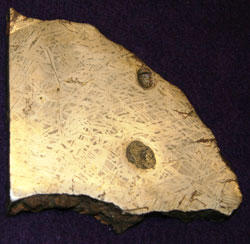![]()
The TCU community doesn’t have to travel to space to rock out.
With the addition of 22 meteorites to the Oscar E. Monnig Meteorite Gallery, space is brought to their very hands.
Arthur Ehlmann, a longtime friend of Oscar E. Monnig and curator of the collection, said 22 meteorite samples were purchased by TCU in February for $70,000 and make up the most recent addition to the Monnig collection. Although Ehlmann said 75 percent of the collection is made up of irons, each sample is individually unique with various sizes, shapes and types.
The Oscar E. Monnig Gallery, located in the Sid Richardson Building, opened for the public in 2003 after longtime meteorite collector Oscar E. Monnig donated the collection to TCU before he died.
Since 2003, the collection has grown with the addition of several hundred specimens every year. Currently, the meteorite count is 1,371 – undoubtedly the largest documented collection in Texas, Ehlmann said.
“I can think of one university that has a parallel to our collection and that is Arizona State University,” Ehlmann said.
Before being purchased, the samples sat in storage at Philadelphia Academy, Ehlmann said. When he heard the academy had no immediate plans for the minerals and meteorites, Ehlmann investigated and sent a friend to purchase them immediately.
“They had been in storage for many years and they had no plans to make any kind of exhibit, so I thought they wouldn’t mind making some money off of them,” Ehlmann said. “There were quite a number of specimens in the original Philadelphia collection that we already had, so the 22 were out of approximately 125.”
Despite the addition of meteorites, the gallery that appears in the Sid Richardson Building has stayed the same since opening in 2003 and showcases less than 10 percent of the collection. Ehlmann said when the gallery was built it was made for only specific meteorites and with its construction there is no way of showcasing recent developments.
“The gallery is fixed,” Ehlmann said. “Even specimen holders are made for individual specimens, so we don’t have a way of showing new developments and we certainly can’t keep them in the lobby.”
Melissa McDermott, a senior physics and astronomy major, has worked with the gallery since July 2005 but has been a friend to the geology department for some time.
McDermott said she is not troubled by the lack of specimens on showcase because everything on display represents the collection adequately. The expansion of the gallery in the future would only increase the number of samples available to children who wish to touch and play with the meteorites, McDermott said.
“We have examples of all different kinds of meteorites and even imprints on how the passage through space affects the meteorite,” McDermott said. “If we changed the gallery or made it bigger, we’d be putting out the same samples just different types, sizes and shapes.”
Richard Hanson, chair of geology, agrees that the lack of specimens on display is not alarming because every meteorite gets its fair share of attention. Hanson said, and although the new samples aren’t on display at the moment he has no doubt they will be helpful for the future.
“The samples are certainly important to the collection as a whole not just for teaching but also for research,” Hanson said. “Meteorites are so fundamental in understanding our earth. We hope to have a wider course offering more devoted to planetary geology where the collection might be more open to students.”
At the time, however, Hanson said the collection on show is perfect for the students’ geology needs.
“The outer part of the gallery has the best examples, a wonderful display and ideal for teaching,” Hanson said.
Teresa Moss, the director of the Monnig Gallery, said the chances of seeing the 22 new meteorites on display are slim.
“They are not on display yet and won’t be in the very near future,” Moss said.
Moss said although the recently added meteorites won’t be behind glass cases, they are still open to the public for viewing upon request and there is no extra charge to see the meteorites. In the meantime, Ehlmann continues to cut, polish and analyze them for future use.





